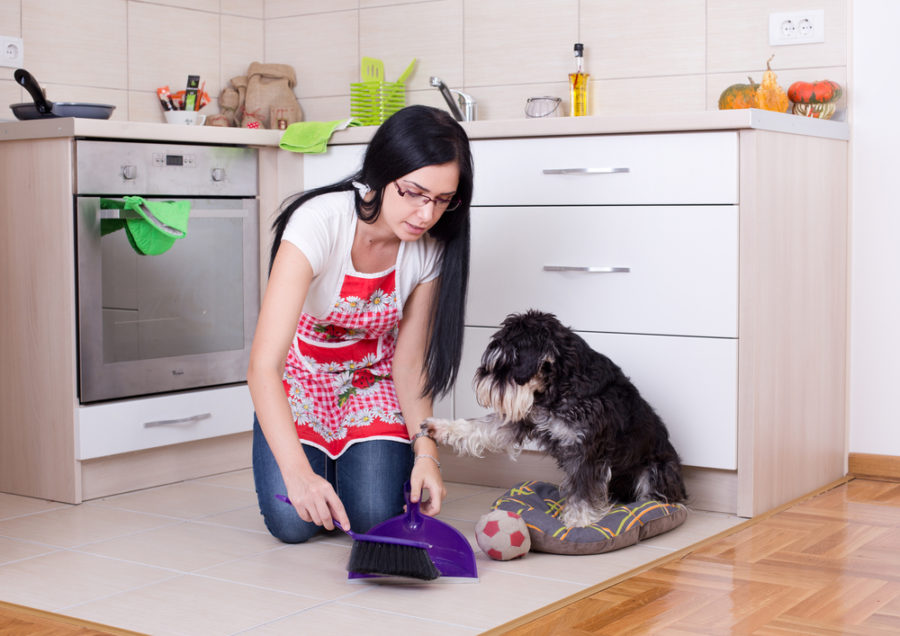Sharing your home with a dog or cat can get messy – especially in the winter. This pet-friendly spring cleaning guide will help sanitize and organize every nook and cranny of his living space.
Spring is finally here. It’s time to open the windows, pack away the dog sweaters, and prepare for some exciting outdoor adventures with your canine companion! But before you get too excited, you may want to do a deep cleaning to rid your home and your pet’s things of dander, germs and dust. This pet-friendly spring cleaning guide should get you on the right track.
Cleaning your pet’s toys
Your pet’s toys spend a lot of time in his mouth. They’re drooled on and are often wet, which is a great place to grow mold and bacteria. After the nasty bacteria is growing, your pet then puts the toy back inside his mouth or tosses it on your nice bed. Yum.
Frist, gather up all your pet’s toys and do a safety check. Are they intact and safe to chew? Or are they getting ripped and tattered? Unsafe pet toys should be thrown away. If first is the only concern, follow the cleaning steps below.
Fill your washing machine with hot water and add ½ cup of distilled white vinegar. Next, place your pet’s fabric toys inside a mesh garment bag and toss into the machine. While you’re at it, toss in his sweaters and jackets. Add your non-toxic, organic detergent. It’s important to remember these items spend a lot of time in your pet’s mouth, so natural products are best. When the cycle is complete, fully dry your pet’s toys on high.
For your pet’s rubber toys, you can make a non-toxic cleaner. In a large bucket, combine 10 cups distilled white vinegar, 10 cups distilled water, ¼ cup non-toxic soap, and 10 drops lavender essential oil. Place your pet’s toys inside the bucket. If any toys are really dirty or moldy, grab a toothbrush and scrub clean. Allow the toys to rest in the solution for an hour. Rinse your pet’s toys with clean water and allow them to fully dry in the bathtub.
Cleaning your cat’s litter box
You can use the same method you used on your pet’s plastic toys on your cat’s litter box! If your cat has more than one litter box, clean one at a time. Remember, kitties can be very fussy about their potty habits, so you might want to do this cleaning quickly.
Dump all your cat’s litter into the garbage. If your cat is prone to not using his litter box, you may want to save a tiny bit of the used litter to place inside the newly cleaned box. Next, scrub the litter box with the natural DIY pet cleaner above. Rinse the litter box, then dry thoroughly with a towel. Fill your cat’s litter box with his non-toxic cat litter and place the box back in its spot.
Cleaning your pet’s bedding
Pet hair, drool, and skin cells are likely to be found in your pet’s bedding. Depending on your pet’s bedding size, you may need to take his blankets to the Laundromat to use an extra-large machine. I would recommend cleaning them yourself versus using a dry cleaner, so you can ensure you are using pet-friendly and non-toxic cleaners. You can wash and dry your pet’s blankets in the same fashion as you washed his toys.
If your pet’s bed has a removable cover, remove the cover and wash in your washing machine with his blankets. If not, sprinkle baking soda on his bed and allow to sit for 30 minutes, then vacuum. Even if you wash the bed cover, it’s still a good idea to do this process on the foam part of the pet bed to absorb any odors and excess moisture.
Cleaning your pet’s collar and leash
Once again, your DIY pet cleaner of vinegar, water, and soap can be used. Simply scrub your pet’s collar and leash with a toothbrush and the solution, rinse clean, and allow to fully air-dry. Voila, your pet’s collar is revived, smells great, and is bacteria free.
Thorough vacuum cleaning
Pet hair is notorious for weaving its way through furniture and hiding in every nook and cranny. Spring cleaning is a great time to move furniture and vacuum in all the spaces you miss during your weekly cleaning. Pull out your dog’s crate, move his toy box, and really get in there. These corners are hiding spots for allergens.
Next year, don’t wait for spring to do your pet’s spring cleaning! Rotate your cleaning process to target one chore a month. This will help ensure your home is germ-free and will speed up the process so it doesn’t feel like such a big chore.








